
DS 7 Crossback SUV (2018-2022) engines, drive and performance
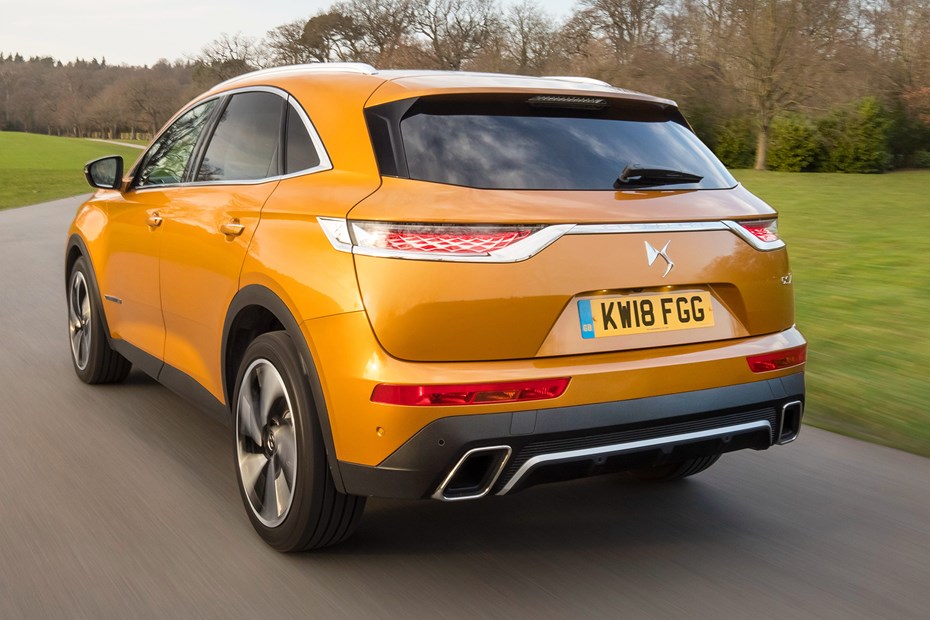
The DS 7 Crossback is offered one diesel, three petrols and a pair of plug-in hybrids. Power outputs range from 130hp to 300hp, so there should be a model for everyone.
Hybrid models and performance
Newest models in the range are the plug-in hybrids, available in 225hp front-wheel drive form and the range-topping E-Tense 300 4x4. This plug-in hybrid combines a 200hp version of the 1.6-litre turbocharged petrol engine with two electric motors – one per axle – that are powered by a 13.2kw lithium-ion battery.
This gives limited amounts of pure electric running, all-wheel drive capability and boosts total power to 300hp, with the 0-62mph sprint covered in 5.9 seconds and a potential top speed of 149mph. The eight-speed automatic gearbox is standard.
On the move, the electrified drivetrain certainly adds to the DS 7’s impressive refinement when operating in pure electric mode – there’s already very little road- or wind noise, and the suspension (at higher speeds more than in town at least) is extremely comfortable, so the lack of engine noise only adds to the relaxing feel.
With the battery fully charged, the DS 7 can energetically surge away from traffic lights without triggering the petrol engine, and is happy to sit at a motorway cruising speed for long periods in pure electric mode too. Accelerate hard in Hybrid or Sport mode and both petrol and electric power join forces, resulting in strong and flexible performance throughout the rev range, though the extra 300kg blunts some urgency.
Refinement is less impressive with the four-cylinder engine running and we did note the occasional clunk as the power sources switched in and out, but generally the transition to petrol power is far from intrusive and still complements the DS 7’s sense of calm.
The BlueHDi 130 is an all-new 1.5-litre engine, passes EU6.2 regulations, and goes on sale early in 2018. This engine will eventually replace all 1.6-litre diesels across the entire PSA range, but for the moment, is only offered across a small selection. We will report back driving impressions of this car when we get hold of one.
All models are front-wheel drive, apart from the hybrid, which has electrically powered rear wheels for improved traction on slippery surfaces.
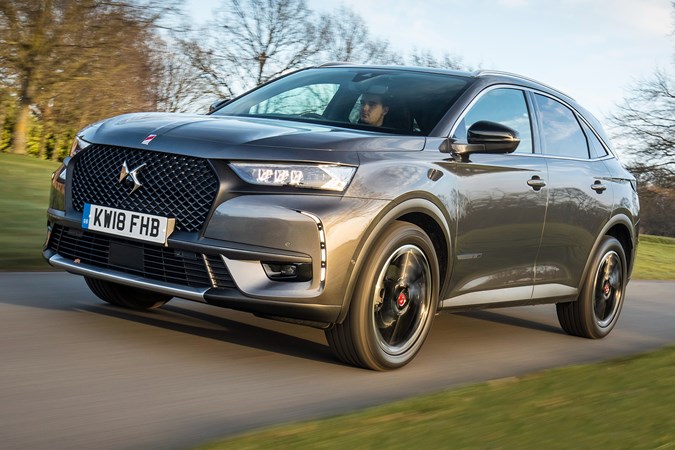
Diesel engines
The BlueHDi 180 in automatic form is punchy, and delivers the goods, it’s also far too vocal. Flick the drive mode switch into sport, and its exhaust note is amplified unpleasantly. We’re not sure why.
Performance is adequate, with a 0-62mph time of 9.9 seconds, and a maximum speed of 134mph – but the engine lacks refinement. We’d recommend you leave it in Eco or Comfort mode, kick back, and try to enjoy the ride.
Petrol engines
We also drove the PureTech 225 in eight-speed automatic form, and it’s smooth and refined at low speeds, and accelerates impressively at motorway speeds. Like the diesel, in Sport mode, the exhaust note is amplified artificially, but it rarely sounds or feels as sporty as its power output would suggest.
Performance is far livelier than the diesel, and you’ll enjoy making the most of it, even if it’s not actually much quicker than the diesel. The 0-62mph time is 8.3 seconds and maximum speed is 141mph – but official fuel consumption of 48.7mpg is lower than the diesel’s 57.6mpg.
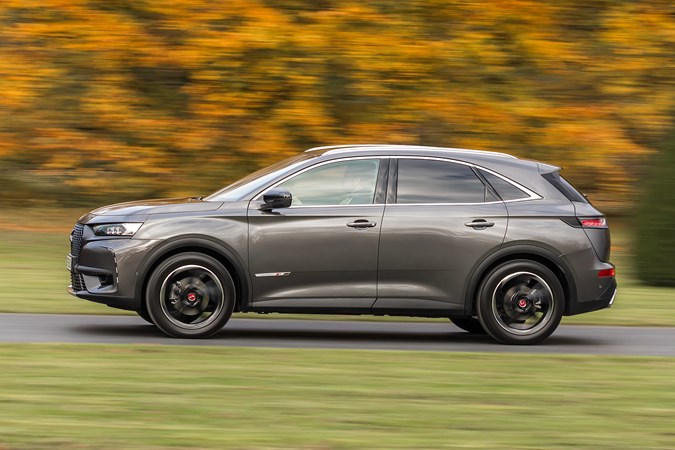
Of the pair, it’s expected that more UK buyers will plump for the diesel on financial grounds, but the petrol version is more satisfying to drive, thanks to its additional refinement. But both are more suited to cruising – which goes hand-in-hand with the DS 7 Crossback’s laid-back character.
Handling
Although SUVs generally aren’t bought by people looking for the most exciting handling, most are confident in bends. The same is true for the DS 7 Crossback, which shares its basic platform and suspension set-up with the excellent Peugeot 3008.
In this case, you’re looking at a car that is biased towards comfort, and as such, the most you’re going to say about the DS 7 Crossback is that it’s capable in corners, and won’t do anything silly.
It’s not a driver’s car, though. The steering is too light and lacks precision which leaves you feeling a bit detached from the road, although it is safe and secure. And the upshot is that you won’t feel that the DS 7 Crossback is ever going to excite you.
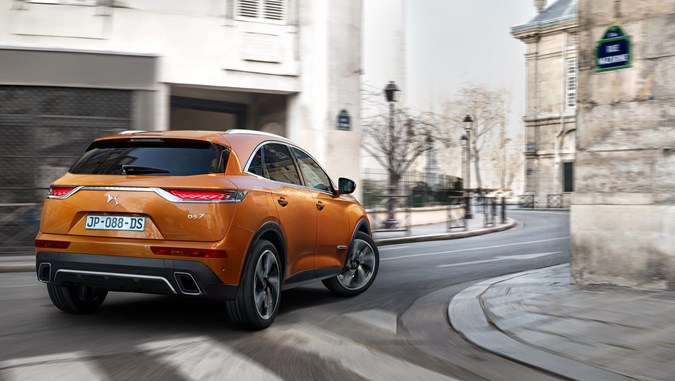
As such, and given the suspension technology that’s gone into it, and the heritage of the brand, this is a little disappointing. But for those drivers looking for a neat handling, undemanding, comfortable family SUV, the DS 7 Crossback puts in an acceptable performance.
How does the plug-in hybrid handle?
The security and refinement of all-wheel drive means it won’t wheelspin out of junctions and scrabble through tight hairpins under harder acceleration like its siblings can, but its extra 300kg of battery and electric motors also works against it.
Much of that additional weight might be positioned low down and therefore in the best possible place for dynamics, but there’s no doubt this feels a relatively tall, bulky car when driven enthusiastically through corners. Driven at a gentler pace, however, the DS 7 Crossback E-Tense feels composed and comfortable, which is probably good enough for most buyers in this segment.

The DS 7 Crossback is offered one diesel, three petrols and a pair of plug-in hybrids. Power outputs range from 130hp to 300hp, so there should be a model for everyone.
Hybrid models and performance
Newest models in the range are the plug-in hybrids, available in 225hp front-wheel drive form and the range-topping E-Tense 300 4x4. This plug-in hybrid combines a 200hp version of the 1.6-litre turbocharged petrol engine with two electric motors – one per axle – that are powered by a 13.2kw lithium-ion battery.
This gives limited amounts of pure electric running, all-wheel drive capability and boosts total power to 300hp, with the 0-62mph sprint covered in 5.9 seconds and a potential top speed of 149mph. The eight-speed automatic gearbox is standard.
On the move, the electrified drivetrain certainly adds to the DS 7’s impressive refinement when operating in pure electric mode – there’s already very little road- or wind noise, and the suspension (at higher speeds more than in town at least) is extremely comfortable, so the lack of engine noise only adds to the relaxing feel.
With the battery fully charged, the DS 7 can energetically surge away from traffic lights without triggering the petrol engine, and is happy to sit at a motorway cruising speed for long periods in pure electric mode too. Accelerate hard in Hybrid or Sport mode and both petrol and electric power join forces, resulting in strong and flexible performance throughout the rev range, though the extra 300kg blunts some urgency.
Refinement is less impressive with the four-cylinder engine running and we did note the occasional clunk as the power sources switched in and out, but generally the transition to petrol power is far from intrusive and still complements the DS 7’s sense of calm.
The BlueHDi 130 is an all-new 1.5-litre engine, passes EU6.2 regulations, and goes on sale early in 2018. This engine will eventually replace all 1.6-litre diesels across the entire PSA range, but for the moment, is only offered across a small selection. We will report back driving impressions of this car when we get hold of one.
All models are front-wheel drive, apart from the hybrid, which has electrically powered rear wheels for improved traction on slippery surfaces.
Diesel and petrol versions
The BlueHDi 180 in automatic form is punchy, and delivers the goods, it’s also far too vocal. Flick the drive mode switch into sport, and its exhaust note is amplified unpleasantly. We’re not sure why.
Performance is adequate, with a 0-62mph time of 9.9 seconds, and a maximum speed of 134mph – but the engine lacks refinement. We’d recommend you leave it in Eco or Comfort mode, kick back, and try to enjoy the ride.
We also drove the PureTech 225 in eight-speed automatic form, and it’s smooth and refined at low speeds, and accelerates impressively at motorway speeds. Like the diesel, in Sport mode, the exhaust note is amplified artificially, but it rarely sounds or feels as sporty as its power output would suggest.
Performance is far livelier than the diesel, and you’ll enjoy making the most of it, even if it’s not actually much quicker than the diesel. The 0-62mph time is 8.3 seconds and maximum speed is 141mph – but official fuel consumption of 48.7mpg is lower than the diesel’s 57.6mpg.

Of the pair, it’s expected that more UK buyers will plump for the diesel on financial grounds, but the petrol version is more satisfying to drive, thanks to its additional refinement. But both are more suited to cruising – which goes hand-in-hand with the DS 7 Crossback’s laid-back character.
Handling
Although SUVs generally aren’t bought by people looking for the most exciting handling, most are confident in bends. The same is true for the DS 7 Crossback, which shares its basic platform and suspension set-up with the excellent Peugeot 3008.
In this case, you’re looking at a car that is biased towards comfort, and as such, the most you’re going to say about the DS 7 Crossback is that it’s capable in corners, and won’t do anything silly.
It’s not a driver’s car, though. The steering is too light and lacks precision which leaves you feeling a bit detached from the road, although it is safe and secure. And the upshot is that you won’t feel that the DS 7 Crossback is ever going to excite you.

As such, and given the suspension technology that’s gone into it, and the heritage of the brand, this is a little disappointing. But for those drivers looking for a neat handling, undemanding, comfortable family SUV, the DS 7 Crossback puts in an acceptable performance.
How does the plug-in hybrid handle?
The security and refinement of all-wheel drive means it won’t wheelspin out of junctions and scrabble through tight hairpins under harder acceleration like its siblings can, but its extra 300kg of battery and electric motors also works against it.
Much of that additional weight might be positioned low down and therefore in the best possible place for dynamics, but there’s no doubt this feels a relatively tall, bulky car when driven enthusiastically through corners. Driven at a gentler pace, however, the DS 7 Crossback E-Tense feels composed and comfortable, which is probably good enough for most buyers in this segment.


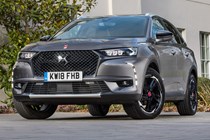
.jpg)
.jpg)
.jpg)
.jpg)
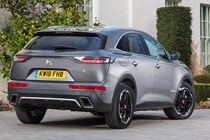

.jpg)
.jpg)
.jpg)
.jpg)
.jpg)
.jpg)
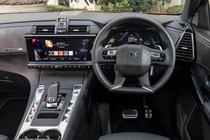
.jpg)
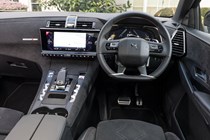
.jpg)
.jpg)
.jpg)

.jpg?quality=50)
.jpg?quality=50)
.jpg?quality=50)
.jpg?quality=50)


.jpg?quality=50)
.jpg?quality=50)
.jpg?quality=50)
.jpg?quality=50)
.jpg?quality=50)
.jpg?quality=50)

.jpg?quality=50)

.jpg?quality=50)
.jpg?quality=50)
.jpg?quality=50)